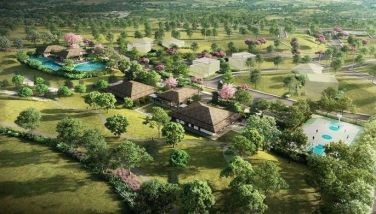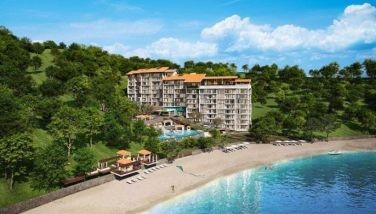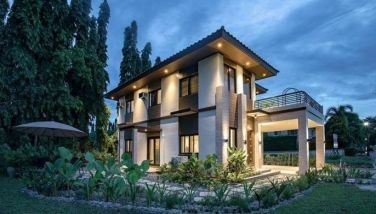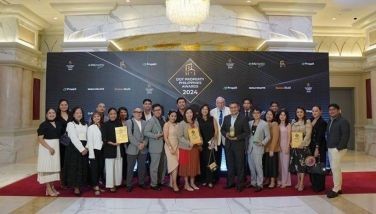P431-M biotech lab turned over to RP
March 8, 2003 | 12:00am
TIGBAUAN, Iloilo – The construction of a world-class biotechnology laboratory here is expected to considerably boost aquaculture research in the country.
The P431-million Laboratory for Advanced Aquaculture Technologies was turned over last Feb.2 7 to the Philippine government by the Japanese government, which provided P400 million for its construction.
The Philippine government gave a counterpart fund of P31 million for the state-of-the-art research facility, which was built within the 40-hectare complex of the Southeast Asian Fisheries Development Center Aquaculture Department (SEAFDEC AQD) in this seaside town 24 kilometers west of Iloilo City.
Agriculture Secretary Luis Lorenzo Jr. received the laboratory in behalf of the Philippines from Japan Embassy First Secretary Eiji Ueno, who represented Japanese Ambassador Kojiro Takano during the turnover ceremony.
Among those who witnessed the turnover were SEAFDEC AQD officials and staff members headed by Dr. Rolando R. Platon, Department of Agriculture (DA) Undersecretary Cesar M. Drilon Jr., Director Felix Gonzales of the Chamber of Fisheries and Aquatic Resources (CFAR), Japan International Cooperation Agency (JICA) resident representative in the Philippines Osamu Nakagaki, officials of the DA-Bureau of Fisheries and Aquatic Resources (CFAR), Japan International Cooperation Agency (JICA) resident representative in the Philippines Osamu Nakagaki, officials of the DA-Bureau of Fisheries and Aquatic Resources (BFAR), Iloilo Gov. Niel Tupas, mayors of some Iloilo towns, and officials of U.P. Visayas and Iloilo State College of Fisheries.
A joint initiative of DA and SEAFDEC AQD, the laboratory will be operated by SEAFDEC AQD and BFAR.
The project was approved by the National Economic and Development Authority (NEDA) and endorsed to the Department of Foreign Affairs (DFA) in August 2000 as among the Philippine government’s "candidate projects" under Japan’s Fiscal Year 2002 General Grant Aid Progrma.
The "Exchange of Notes" by then Ambassador Yoshihisa Ara and Vice President and then concurrent DFA Secretary Teofisto Guingona representing their respective governments took place on Dec. 12, 2001.
The cornerstone-laying for the laboratory was held on Feb. 23, 2002.
Construction of the structure was completed in a year’s time by the contractors – CRC Overseas Corp., Taisei Corp., and Marubeni.
In his acceptance speech, Lorenzo said that the laboratory was established by the Japanese and Philippine governments to maximize gains from aquaculture production in the country and in Southeast Asia without jeopardizing the sustainability of the environment and the industry itself.
The laboratory has five components.
These are Endocrinology and Genetics (to undertake genetic improvement of aquaculture species), Technology (to ensure the rapid growth of cultured fish species), Algal Production Technology (to develop genetically improved seaweed stocks and efficient waste management techniques), Microbiology (to develop rapid disease detection systems and effective vaccines and cures against fish and seaweed diseases), and Enclosed Wet Laboratory (the starting point for testing new strains, new vaccines, new probiotics, and bioremediation agents).
Lorenzo concluded: "I urge the researchers and workers from various institutions who will be working here to make this laboratory the center of biotechnology for aquaculture not only in the Philippines but also in the whole of Southeast Asia."
The P431-million Laboratory for Advanced Aquaculture Technologies was turned over last Feb.2 7 to the Philippine government by the Japanese government, which provided P400 million for its construction.
The Philippine government gave a counterpart fund of P31 million for the state-of-the-art research facility, which was built within the 40-hectare complex of the Southeast Asian Fisheries Development Center Aquaculture Department (SEAFDEC AQD) in this seaside town 24 kilometers west of Iloilo City.
Agriculture Secretary Luis Lorenzo Jr. received the laboratory in behalf of the Philippines from Japan Embassy First Secretary Eiji Ueno, who represented Japanese Ambassador Kojiro Takano during the turnover ceremony.
Among those who witnessed the turnover were SEAFDEC AQD officials and staff members headed by Dr. Rolando R. Platon, Department of Agriculture (DA) Undersecretary Cesar M. Drilon Jr., Director Felix Gonzales of the Chamber of Fisheries and Aquatic Resources (CFAR), Japan International Cooperation Agency (JICA) resident representative in the Philippines Osamu Nakagaki, officials of the DA-Bureau of Fisheries and Aquatic Resources (CFAR), Japan International Cooperation Agency (JICA) resident representative in the Philippines Osamu Nakagaki, officials of the DA-Bureau of Fisheries and Aquatic Resources (BFAR), Iloilo Gov. Niel Tupas, mayors of some Iloilo towns, and officials of U.P. Visayas and Iloilo State College of Fisheries.
A joint initiative of DA and SEAFDEC AQD, the laboratory will be operated by SEAFDEC AQD and BFAR.
The project was approved by the National Economic and Development Authority (NEDA) and endorsed to the Department of Foreign Affairs (DFA) in August 2000 as among the Philippine government’s "candidate projects" under Japan’s Fiscal Year 2002 General Grant Aid Progrma.
The "Exchange of Notes" by then Ambassador Yoshihisa Ara and Vice President and then concurrent DFA Secretary Teofisto Guingona representing their respective governments took place on Dec. 12, 2001.
The cornerstone-laying for the laboratory was held on Feb. 23, 2002.
Construction of the structure was completed in a year’s time by the contractors – CRC Overseas Corp., Taisei Corp., and Marubeni.
In his acceptance speech, Lorenzo said that the laboratory was established by the Japanese and Philippine governments to maximize gains from aquaculture production in the country and in Southeast Asia without jeopardizing the sustainability of the environment and the industry itself.
The laboratory has five components.
These are Endocrinology and Genetics (to undertake genetic improvement of aquaculture species), Technology (to ensure the rapid growth of cultured fish species), Algal Production Technology (to develop genetically improved seaweed stocks and efficient waste management techniques), Microbiology (to develop rapid disease detection systems and effective vaccines and cures against fish and seaweed diseases), and Enclosed Wet Laboratory (the starting point for testing new strains, new vaccines, new probiotics, and bioremediation agents).
Lorenzo concluded: "I urge the researchers and workers from various institutions who will be working here to make this laboratory the center of biotechnology for aquaculture not only in the Philippines but also in the whole of Southeast Asia."
BrandSpace Articles
<
>
- Latest
Latest
Latest
October 23, 2024 - 9:30am
By May Dedicatoria | October 23, 2024 - 9:30am
October 11, 2024 - 3:45pm
October 11, 2024 - 3:45pm
October 10, 2024 - 11:30am
October 10, 2024 - 11:30am
October 5, 2024 - 12:08pm
October 5, 2024 - 12:08pm
September 24, 2024 - 1:00pm
September 24, 2024 - 1:00pm
September 13, 2024 - 4:00pm
September 13, 2024 - 4:00pm
Recommended





























